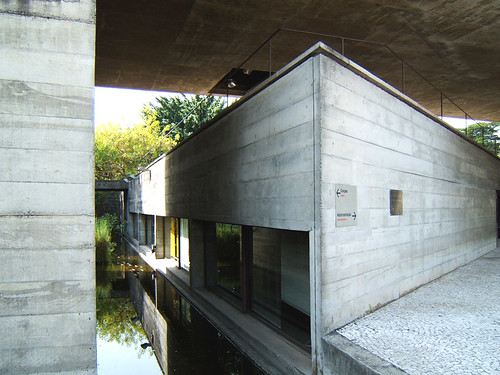A look back at the year that was, as documented by this ol' blog.
In January, I visited 30 buildings in 30 days.
In February, the AIA released its 150 favorite structures (as picked by 1,800 Americans); the Grand Canyon Skywalk was under construction; Archinect gave us some reading suggestions; I wrote a paper on film noir and the automobile.
In March, select New Yorkers picked the ugliest buildings in New York; Architecture for Humanity released its Open Architecture Network; Banana Republic used architects to shill their merchandise; somebody bought a Peter Zumthor monograph for $836.00; Death by Architecture returned, redesigned; Richard Rogers won the Pritzker Prize.
In April, SANAA made Swiss cheese; I started literary dosing (in between my 40 Bond dumpster dives); Eikongraphia made a list; the Parasol rose; I chimed in on the reappraisal of Robert Moses.
In May, Burj Dubai reached halfway; Bruder Klaus Chapel was photographed; OMA and Foster squared off in the desert; Maison Tropicale was open for potential bidders; Google released Street Views; Postopolis! videotaped itself (beware, memory-intensive link!).
In June, I graduated from City College; a pink blob overtook Atlantic Yards; The Archi-Tourist moved (and it will be updated again, one of these days, I promise!); a Waldspirale was designed for The Bronx; the East River got crowded; Serra wowed MoMA visitors; One Jackson Square undulated; Stout started selling Kidder Smith's old library; I saw Manufactured Landscapes.
In July, I went on a road trip...to Washington D.C.; I started looking at firm faces; Inversion got the meme treatment; Charlie Kaufman started a new film; Queens residents poo-pooed a McModern; MVRDV designed a massive LACK table; Snøhetta played with sand.
In August, Charles Eames turned 100 (not really); I analyzed advertising on architecture blogs; Chuck E. Cheese took over Simmons Hall.
In September, The World Edition launched; I caught some Jihad Pop; Kolumba opened; Paul Rudolph buildings got torn apart; a Hadid saw better days.
In October, 12 Blocks won an award; a Holl building opened (no, not that one); I experienced A Psychic Vacuum; Richard Meier showed us some of his sculptures; Atelier Bow-Wow showed us their Graphic Anatomy; I tried to show a sense of solar scale; I reconsidered Javits Plaza; Ponte City was transformed (or at least marketed) for the upper class.
In November, I visited some NYC bookstores; an urban lobby emerged; a new Nouvel was unveiled; city planners and academics debated PLaNYC; I went home again and pondered a suburban future.
In December, the New New Museum opened; Hudson Yards was given the big developer, big architect treatment; you bought some holiday gift books; Oscar turned 100 (really); I visited Chicago and recapped the transformation; I recapped 2007.
Architectural engineering design.autocad career .learnin,news,architecture design tutorial,
Monday, December 31, 2007
2007 Weekly Favs
Here's a rundown of my ten favorite projects (out of 49) featured on my weekly page in 2007, in order of their appearance.
While I'm at it, here's my ten favorite books (out of 46) featured on my weekly page in 2007, in order of appearance. Keep in mind that not all books were published in 2007. The same can be said of the buildings above; many of them were completed previous to 2007.
Tietgen Residence Hall in Copenhagen, Denmark by Lundgaard & Tranberg
Nazarí Wall Intervention in Granada, Spain by Antonio Jiménez Torrecillas
Christ Church Tower in London, England by Boyarsky Murphy Architects
Housing at Westport, County Mayo, Ireland by Richard Murphy Architects & Taylor Architects
Handmade School in Rudrapur, Bangladesh by Roswag & Jankowski and Anna F. Heringer
Casa no Gerês in Gerês, Portugal by Graça Correia Arquitectos
Centro das Artes | Casa das Mudas in Calheta, Madeira by Paulo David
Instituto Rafael Arozarena in La Orotava, Tenerife by AMP Arquitectos
Nebesa Mountain Retreat in Livek, Slovenia by REAL Engineering
Termas Géometricas in Villarrica, Chile by Germán del Sol
:: Sensory Design, by Joy Monice Malnar and Frank Vodvarka
:: The Suburbanization of New York, edited by Jerilou Hammett and Kingsley Hammett
:: Function of Ornament, edited by Farshid Moussavi and Michael Kubo
:: Interpreting Nature, by I. G. Simmons
:: Formula New Ljubljana, by Sadar Vuga Arhitekti.
:: Materials for Design, by Victoria Ballard Bell with Patrick Rand
:: Desert America, edited by Ramon Prat, Jaime Salazar, Michael Kubo & Irene Hwang
:: The Hanging Cemetery of Baghdad, by NaJa & deOstos.
:: Strange Details, by Michael Cadwell
:: Architectural Regionalism, edited by Vincent B. Canizaro.
Monday, Monday
My weekly page update:

Ann Demeulemeester Shop in Seoul, South Korea by Mass Studies.
The updated book feature is The Landscape Urbanism Reader, edited by Charles Waldheim and Large Parks, edited by Julia Czerniak and George Hargreaves.
Some unrelated links for your enjoyment:

Ann Demeulemeester Shop in Seoul, South Korea by Mass Studies.
The updated book feature is The Landscape Urbanism Reader, edited by Charles Waldheim and Large Parks, edited by Julia Czerniak and George Hargreaves.
Some unrelated links for your enjoyment:
Daily Blue Print
A site "constantly monitoring the top blogs and blog posts on Architecture. " (added to sidebar under blogs::aggregate)
(CRIT)
Design blog of the MFA Graduate Program at the School of Visual Arts. (added to sidebar under blogs::design+technology)
The Iaakuza Chronicles
Newish, well-done blog by an Italian architectural engineer. (added to sidebar under blogs::architecture)
The Back-of-the-Envelope Bush Library Design Contest
The Chronicle for Higher Education is looking for "designs that are serious, humorous, adventurous, or all of the above" if you were to design George W. Bush's Presidential Library.
Saturday, December 29, 2007
The year is 2099...
"A magnetically levitated train could theoretically take you from New York to London in 54 minutes," the Discovery Channel informs us. "But you'd have to go 5,000 mph through a 3,100-mile-long tunnel that was itself floating in the Atlantic Ocean. How might that work?"
Well, let's find out.
Of course, if this interests you, don't miss parts two and three.
Well, let's find out.
Of course, if this interests you, don't miss parts two and three.
Friday, December 28, 2007
3 Blocks, 5 Buildings, 18 Months Later
Back in April 2006 I posted a panorama of a small area in Chicago's Streeterville neighborhood undergoing a bit of a high rise building binge. About a year and a half later -- while in town on a vacation over Thanksgiving -- the shifting skyline was starting to take shape, with cranes giving way to glassy exterior walls and approximately 1,000 residential units.
To reiterate from the earlier post, the five new condo towers include (from E-W; L-R in the large photo):

Click image for larger, keyed before-and-after view
This view from the raised plaza adjacent to NBC Tower will be further crowded by the coming phases of Cityfront Plaza, which will finally steal the sunlight and views the Grand Ohio condos have been blessed with all these years. And interestingly, even though the Cor-Ten and gold-tinted glass Time-Life Building is out of direct sight in the view, it is apparent as a reflection in Jahn's curtain wall, with especially strong reflections from the gold windows on its base.
Who'd ever think so much development and money would be centered on land named after a founding "squatter"?
To reiterate from the earlier post, the five new condo towers include (from E-W; L-R in the large photo):
:: Avenue East by Built Form
:: 535 North St. Clair by Brininstool + Lynch
:: 600 North Fairbanks by Helmut Jahn
:: Cityfront Plaza by DeStefano + Partners
:: The Streeter (rentals) by Solomon Cordwell Buenz

Click image for larger, keyed before-and-after view
This view from the raised plaza adjacent to NBC Tower will be further crowded by the coming phases of Cityfront Plaza, which will finally steal the sunlight and views the Grand Ohio condos have been blessed with all these years. And interestingly, even though the Cor-Ten and gold-tinted glass Time-Life Building is out of direct sight in the view, it is apparent as a reflection in Jahn's curtain wall, with especially strong reflections from the gold windows on its base.
Who'd ever think so much development and money would be centered on land named after a founding "squatter"?
Today's archidose #164
Brazilian Museum of Sculpture in São Paulo, Brazil by Paulo Mendes da Rocha. (1988)
To contribute your Flickr images for consideration, just:
:: Join and add photos to the archidose pool, and/or
:: Tag your photos archidose
Thursday, December 27, 2007
All eyes on the city
Like some rogue branch of the independent film industry, private security firms are now installing what The New York Times calls "one of the most comprehensive high-tech public surveillance systems in the world," and they're doing it in China.
 [Image: Surveillance cameras for sale in China; photo by Timothy O'Rourke for The New York Times].
[Image: Surveillance cameras for sale in China; photo by Timothy O'Rourke for The New York Times].
While these cameras and other forms of remote sensing are being installed to keep Olympic athletes and their screaming fans safe during the coming summer's Games, the worry is that the surveillance will simply stay put:
James Mulvenon, director of the Center for Intelligence Research and Analysis, remarks that "the pace of technological change means that products with mainly civilian applications, like management computer systems with powerful video surveillance features, [have] blurred the distinction between law enforcement and civilian technologies." And it's in that blurring that some U.S. security firms have potentially brushed up against the outer edge of illegal commercial activity: that is, supplying China with these cameras might at least partially violate "a sanctions law Congress passed after the Tiananmen Square killings" in 1989.
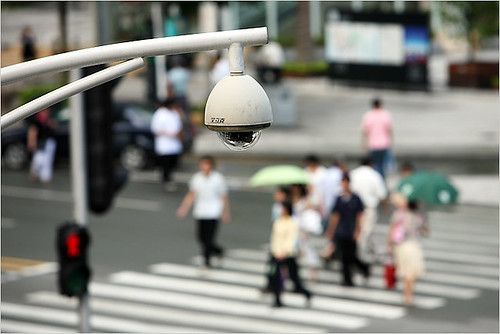 [Image: Surveillance in China; photographer temporarily unknown, though this appeared in The New York Times several months ago].
[Image: Surveillance in China; photographer temporarily unknown, though this appeared in The New York Times several months ago].
All of this also highlights the increasingly intense overlap between film production, the political administration of urban space, and the private security industry, whereby three otherwise unrelated fields become nearly indistinguishable from one another – or, perhaps more accurately phrased, they become erstwhile partners in pursuit of different goals.
In fact, I have often thought it would be interesting – and I have actually written an entire unpublished novel about a very similar idea, set in London (attention, editors! seriously!) – if a well-known, and wealthy, film production firm such as Universal Pictures, or Warner Brothers, or even Film Four, were to sign a legal contract with, for example, the City of London, after which Universal would financially underwrite the installation of a brand new and geographically extensive security camera system.
Universal (or whomever – maybe Bollywood will do this) would retain all legal rights to the footage thus generated – the ultimate reality TV show: London in real-time – yet they'd be contractually obligated to let the City of London use the footage for law enforcement purposes. Beyond a certain timeframe, though, Universal keeps all the film.
Meanwhile, the City has found itself an additional revenue stream and a partner in fighting crime (or, at least, in filming it), and reality TV – reality cinema – has never had it so good. A bottomless well of new footage.
All London needs is a good editor™.
So might that be the urban security model of the future? Cities will lease urban image rights to film production firms? Your willful participation will simply be assumed.
Soon, London, New York, and Tokyo are owned by Sony Pictures; Paris, Rome, and New Delhi sign binding contracts with Warner Brothers; and every other city in between falls to one of half a dozen rival production companies.
Armed film companies replace mayors and town halls as the urban administrators of tomorrow.
Taxes are cut almost to nothing: government revenue is entirely film-generated. You can syndicate the events of yesterday on televisions round the world, and earn tens of millions of euros in the process.
After all, what would you do if you found out that New Line Cinema, or Dreamworks, or Canal+, had just installed tens of thousands of cameras throughout greater Moscow – and that the footage being generated was starting to show up on TV?
We are the stars now®.
Perhaps I should add that I think this is a very dystopian scenario, and I am not at all advocating that it be implemented; nonetheless, the literary and cinematic possibilities are, for me, quite exciting – and, to be frank, it sounds financial workable for both parties.
In any case, if you're off to Beijing for the Olympics next summer, don't forget to look your best: you'll be on film...
(Vaguely related: Filmmaker Adam Rifkin talks to Wired about the cinematic possibilities of CCTV – with belated thanks to Christopher Stack!)
 [Image: Surveillance cameras for sale in China; photo by Timothy O'Rourke for The New York Times].
[Image: Surveillance cameras for sale in China; photo by Timothy O'Rourke for The New York Times].While these cameras and other forms of remote sensing are being installed to keep Olympic athletes and their screaming fans safe during the coming summer's Games, the worry is that the surveillance will simply stay put:
- Long after the visitors leave, security industry experts say, the surveillance equipment that Western companies leave behind will provide the authorities here with new tools to track not only criminals, but dissidents too... Indeed, the autumn issue of the magazine of China’s public security ministry prominently listed places of religious worship and Internet cafes as locations to install new cameras.
- Honeywell has already started helping the police to set up an elaborate computer monitoring system to analyze feeds from indoor and outdoor cameras in one of Beijing’s most populated districts, where several Olympic sites are located. The company is working on more expansive systems in Shanghai, in preparation for the 2010 World Expo there – in addition to government and business security systems in Guangzhou, Shenzhen, Nanjing, Changsha, Tianjin, Kunming and Xi’an. General Electric has sold to Chinese authorities its powerful VisioWave system, which allows security officers to control thousands of video cameras simultaneously and automatically alerts them to suspicious or fast-moving objects, like people running. The system will be deployed at Beijing’s national convention center, including the Olympics media center. I.B.M. is installing a similar system in Beijing that should be ready before the Olympics and will analyze and catalog people and behavior.
James Mulvenon, director of the Center for Intelligence Research and Analysis, remarks that "the pace of technological change means that products with mainly civilian applications, like management computer systems with powerful video surveillance features, [have] blurred the distinction between law enforcement and civilian technologies." And it's in that blurring that some U.S. security firms have potentially brushed up against the outer edge of illegal commercial activity: that is, supplying China with these cameras might at least partially violate "a sanctions law Congress passed after the Tiananmen Square killings" in 1989.
 [Image: Surveillance in China; photographer temporarily unknown, though this appeared in The New York Times several months ago].
[Image: Surveillance in China; photographer temporarily unknown, though this appeared in The New York Times several months ago].All of this also highlights the increasingly intense overlap between film production, the political administration of urban space, and the private security industry, whereby three otherwise unrelated fields become nearly indistinguishable from one another – or, perhaps more accurately phrased, they become erstwhile partners in pursuit of different goals.
In fact, I have often thought it would be interesting – and I have actually written an entire unpublished novel about a very similar idea, set in London (attention, editors! seriously!) – if a well-known, and wealthy, film production firm such as Universal Pictures, or Warner Brothers, or even Film Four, were to sign a legal contract with, for example, the City of London, after which Universal would financially underwrite the installation of a brand new and geographically extensive security camera system.
Universal (or whomever – maybe Bollywood will do this) would retain all legal rights to the footage thus generated – the ultimate reality TV show: London in real-time – yet they'd be contractually obligated to let the City of London use the footage for law enforcement purposes. Beyond a certain timeframe, though, Universal keeps all the film.
Meanwhile, the City has found itself an additional revenue stream and a partner in fighting crime (or, at least, in filming it), and reality TV – reality cinema – has never had it so good. A bottomless well of new footage.
All London needs is a good editor™.
So might that be the urban security model of the future? Cities will lease urban image rights to film production firms? Your willful participation will simply be assumed.
Soon, London, New York, and Tokyo are owned by Sony Pictures; Paris, Rome, and New Delhi sign binding contracts with Warner Brothers; and every other city in between falls to one of half a dozen rival production companies.
Armed film companies replace mayors and town halls as the urban administrators of tomorrow.
Taxes are cut almost to nothing: government revenue is entirely film-generated. You can syndicate the events of yesterday on televisions round the world, and earn tens of millions of euros in the process.
After all, what would you do if you found out that New Line Cinema, or Dreamworks, or Canal+, had just installed tens of thousands of cameras throughout greater Moscow – and that the footage being generated was starting to show up on TV?
We are the stars now®.
Perhaps I should add that I think this is a very dystopian scenario, and I am not at all advocating that it be implemented; nonetheless, the literary and cinematic possibilities are, for me, quite exciting – and, to be frank, it sounds financial workable for both parties.
In any case, if you're off to Beijing for the Olympics next summer, don't forget to look your best: you'll be on film...
(Vaguely related: Filmmaker Adam Rifkin talks to Wired about the cinematic possibilities of CCTV – with belated thanks to Christopher Stack!)
Wednesday, December 26, 2007
Adventures in Stacking
New Scientist published an awesome article this week about nothing more complex than stacking blocks of wood (subscriber-only)... But, oh, how complex that task can be. It's the combinatorial architecture of the well-balanced stack.
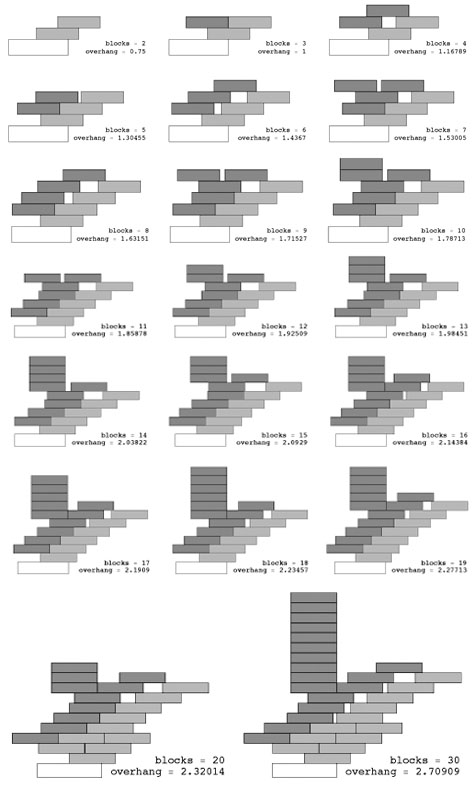 [Image: The diagrammatic mathematics of a structural experiment by Mike Paterson and Uri Zwick, as reported in New Scientist].
[Image: The diagrammatic mathematics of a structural experiment by Mike Paterson and Uri Zwick, as reported in New Scientist].
Computer scientists Mike Paterson and Uri Zwick have calculated new shapes and arrangements for the so-called "overhang problem," by which one attempts to stack blocks outward from the edge of a table so that the blocks "overhang" as far as possible (before the stack collapses, or before you and your friends go out for more beer).
Strategically speaking, it turns out to be a matter of well-placed gaps, pressures, and weights.
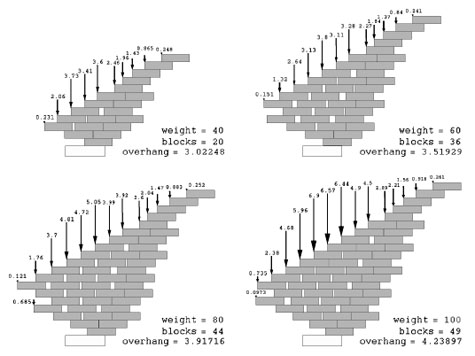 [Image: Two abstract stacks by Mike Paterson and Uri Zwick].
[Image: Two abstract stacks by Mike Paterson and Uri Zwick].
In two papers, available as PDFs (here and here), Paterson and Zwick write about balancing "harmonic stacks," then stabilizing them, through "minute displacements" of space and weight within the stack structure.
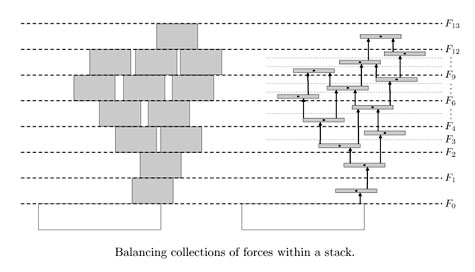 [Image: May the force stack with you; diagram by Mike Paterson and Uri Zwick].
[Image: May the force stack with you; diagram by Mike Paterson and Uri Zwick].
The authors advise that
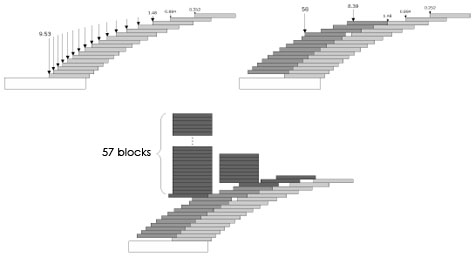 [Image: More stack madness by Mike Paterson and Uri Zwick].
[Image: More stack madness by Mike Paterson and Uri Zwick].
But what are the architectural implications of all this? Are there any?
Or, in this age of advanced materials, are basic formal considerations such as these reduced to useless tinkering? Why worry about well-balanced stacks, in other words, when you can just put some cantilevered I-beams up there and be done with it, making experiments like these instantaneously obsolete?
Superficially, these diagrams actually remind me of the demolition of London's P&O Building this summer, in which the building was taken apart from the ground up, as if disappearing into the sky – thus exhibiting a rather unique variety of the overhang problem.
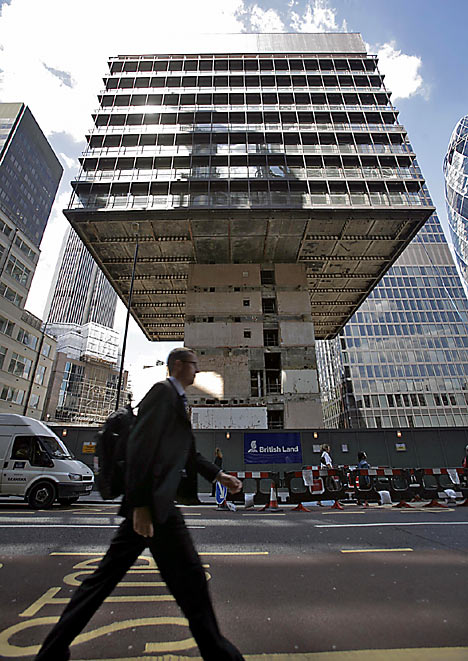 [Image: London's P&O Building gets demolished in reverse; via the Daily Mail. To see what brain death feels like, meanwhile, don't miss the typically moronic comment thread over at Gizmodo, where brains go to die].
[Image: London's P&O Building gets demolished in reverse; via the Daily Mail. To see what brain death feels like, meanwhile, don't miss the typically moronic comment thread over at Gizmodo, where brains go to die].
So are there tens of thousands of overhang problems on display right now in the jungly tangles of rebar and steel that remain camouflaged behind the facades of architectural structures? Deep in the guts of engineered buildings the world over, are there interesting mathematical lessons to learn – provided we change how we look at walls and windows?
Is this the architectural equivalent of Rimbaud's "systematic derangement of the senses" – to see mathematics and topology where others see mere elevators and unused attic floors? Inside our buildings, might there yet be more to find?
 [Image: View larger! Speculative demolition in Halle-Neustadt, via Nickzilla].
[Image: View larger! Speculative demolition in Halle-Neustadt, via Nickzilla].
We could actually attempt to answer that question.
Given billions of dollars, zero insurance liability, and a whole fleet of Komatsu wrecking machines, could you re-examine the overhang problem from an architectural standpoint, seeing how many floors and offices you can remove before a building tips over?
You'd make little Gordon Matta-Clark-esque incisions throughout the city – taking out whole floors and elevator shafts – cutting away at every building, one executive office suite at a time, till each building begins to tilt, warp, or list... at which point you'd stop, take a photograph, calculate something, then submit the image to a mathematics journal, thus winning the next Fields Medal for Applied Mathematics.
All of Manhattan a demolitionist research lab for extremely well-funded and aggressive mathematicians.
Could you then exhibit these removed pieces elsewhere – showing, say, the entire, fully intact eastern elevator shaft from the Empire State Building at the Guggenheim Abu Dhabi, forming some weird and abstract concrete pillar in the sky, whistling quietly in the desert wind, home to seagulls?
Modernist Totem Poles, you'd call it – and you could then steal the elevator shafts from the Transamerica Pyramid, the Sears Tower, the Chrysler Building, and Taipei 101.
In any case, does the stacking problem contain an architectural lesson? Read the original two papers featured in New Scientist to find out.
 [Image: The diagrammatic mathematics of a structural experiment by Mike Paterson and Uri Zwick, as reported in New Scientist].
[Image: The diagrammatic mathematics of a structural experiment by Mike Paterson and Uri Zwick, as reported in New Scientist].Computer scientists Mike Paterson and Uri Zwick have calculated new shapes and arrangements for the so-called "overhang problem," by which one attempts to stack blocks outward from the edge of a table so that the blocks "overhang" as far as possible (before the stack collapses, or before you and your friends go out for more beer).
Strategically speaking, it turns out to be a matter of well-placed gaps, pressures, and weights.
 [Image: Two abstract stacks by Mike Paterson and Uri Zwick].
[Image: Two abstract stacks by Mike Paterson and Uri Zwick].In two papers, available as PDFs (here and here), Paterson and Zwick write about balancing "harmonic stacks," then stabilizing them, through "minute displacements" of space and weight within the stack structure.
- A stack is said to be balanced if there exists a collection of forces acting between the blocks along their contact intervals, such that under this collection of forces, and the gravitational forces acting on them, all blocks are in equilibrium.
 [Image: May the force stack with you; diagram by Mike Paterson and Uri Zwick].
[Image: May the force stack with you; diagram by Mike Paterson and Uri Zwick].The authors advise that
- one should, at least in principle, consider all possible combinatorial stack structures and for each of them find an optimal placement of the blocks. The combinatorial structure of a stack specifies the contacts between the blocks of the stack, i.e., which blocks rest on which, and in what order (from left to right), and which rest on the table.
 [Image: More stack madness by Mike Paterson and Uri Zwick].
[Image: More stack madness by Mike Paterson and Uri Zwick].But what are the architectural implications of all this? Are there any?
Or, in this age of advanced materials, are basic formal considerations such as these reduced to useless tinkering? Why worry about well-balanced stacks, in other words, when you can just put some cantilevered I-beams up there and be done with it, making experiments like these instantaneously obsolete?
Superficially, these diagrams actually remind me of the demolition of London's P&O Building this summer, in which the building was taken apart from the ground up, as if disappearing into the sky – thus exhibiting a rather unique variety of the overhang problem.
 [Image: London's P&O Building gets demolished in reverse; via the Daily Mail. To see what brain death feels like, meanwhile, don't miss the typically moronic comment thread over at Gizmodo, where brains go to die].
[Image: London's P&O Building gets demolished in reverse; via the Daily Mail. To see what brain death feels like, meanwhile, don't miss the typically moronic comment thread over at Gizmodo, where brains go to die].So are there tens of thousands of overhang problems on display right now in the jungly tangles of rebar and steel that remain camouflaged behind the facades of architectural structures? Deep in the guts of engineered buildings the world over, are there interesting mathematical lessons to learn – provided we change how we look at walls and windows?
Is this the architectural equivalent of Rimbaud's "systematic derangement of the senses" – to see mathematics and topology where others see mere elevators and unused attic floors? Inside our buildings, might there yet be more to find?
 [Image: View larger! Speculative demolition in Halle-Neustadt, via Nickzilla].
[Image: View larger! Speculative demolition in Halle-Neustadt, via Nickzilla].We could actually attempt to answer that question.
Given billions of dollars, zero insurance liability, and a whole fleet of Komatsu wrecking machines, could you re-examine the overhang problem from an architectural standpoint, seeing how many floors and offices you can remove before a building tips over?
You'd make little Gordon Matta-Clark-esque incisions throughout the city – taking out whole floors and elevator shafts – cutting away at every building, one executive office suite at a time, till each building begins to tilt, warp, or list... at which point you'd stop, take a photograph, calculate something, then submit the image to a mathematics journal, thus winning the next Fields Medal for Applied Mathematics.
All of Manhattan a demolitionist research lab for extremely well-funded and aggressive mathematicians.
Could you then exhibit these removed pieces elsewhere – showing, say, the entire, fully intact eastern elevator shaft from the Empire State Building at the Guggenheim Abu Dhabi, forming some weird and abstract concrete pillar in the sky, whistling quietly in the desert wind, home to seagulls?
Modernist Totem Poles, you'd call it – and you could then steal the elevator shafts from the Transamerica Pyramid, the Sears Tower, the Chrysler Building, and Taipei 101.
In any case, does the stacking problem contain an architectural lesson? Read the original two papers featured in New Scientist to find out.
Tuesday, December 25, 2007
Planet Battery
A few months back, Nature published an article stating that the "Earth beneath our feet might act as a gigantic circuit built by microbes to power their metabolic systems."
 It's not a planet at all, then, but a bio-electrical deposit rotating in space. A living battery.
It's not a planet at all, then, but a bio-electrical deposit rotating in space. A living battery.
And while that obviously sounds far-fetched, we actually read that these microbes function as a "geological battery," and that this battery is made from "networks of tiny wires linking individual bacterial cells into a web-like electrical circuit." These circuits could extend for miles – hundreds of miles – whole continents and island chains, linked by reefs.
Who knows?
The article also describes these things as "sediment batteries" – so I have a hard time not imagining some old river in the Andes coming down out of its mountain chain, weathering through and eroding the outer soils and bedrock, exposing elemental belts of copper, silver, zinc, and gold, then depositing those fragments in vast, glittering deltaic arrays downstream.
Over the years, microbes move in; the sediments, hundreds of feet deep now and miles wide, begin fluttering with an undetectably faint electrical trace; finally, that remote riverbed, with its weird subsurface nets of energy, and its scattered metals, and its rare microbes, begins generating power... Birds flock toward it, their migration routes scrambled. Nearby compasses go akimbo.
Over the hills, there is a valley of light. You walk toward it.
The Earth is shining.
Religions develop. Their adherents worship geological deposits.
The person in charge of researching all this is called a geobiologist. One such researcher quips that he's been studying "microbe-driven sediment batteries."
Someday you'll just take a power cord – and plug it into the Earth.
(You can read the original article in this PDF. See also BLDGBLOG's look at the wire garden – and, of course, Merry Christmas! May your day be free of desolation and abandonment. And thanks, Steve, for originally pointing this story out to me).
 It's not a planet at all, then, but a bio-electrical deposit rotating in space. A living battery.
It's not a planet at all, then, but a bio-electrical deposit rotating in space. A living battery.And while that obviously sounds far-fetched, we actually read that these microbes function as a "geological battery," and that this battery is made from "networks of tiny wires linking individual bacterial cells into a web-like electrical circuit." These circuits could extend for miles – hundreds of miles – whole continents and island chains, linked by reefs.
Who knows?
The article also describes these things as "sediment batteries" – so I have a hard time not imagining some old river in the Andes coming down out of its mountain chain, weathering through and eroding the outer soils and bedrock, exposing elemental belts of copper, silver, zinc, and gold, then depositing those fragments in vast, glittering deltaic arrays downstream.
Over the years, microbes move in; the sediments, hundreds of feet deep now and miles wide, begin fluttering with an undetectably faint electrical trace; finally, that remote riverbed, with its weird subsurface nets of energy, and its scattered metals, and its rare microbes, begins generating power... Birds flock toward it, their migration routes scrambled. Nearby compasses go akimbo.
Over the hills, there is a valley of light. You walk toward it.
The Earth is shining.
Religions develop. Their adherents worship geological deposits.
The person in charge of researching all this is called a geobiologist. One such researcher quips that he's been studying "microbe-driven sediment batteries."
Someday you'll just take a power cord – and plug it into the Earth.
(You can read the original article in this PDF. See also BLDGBLOG's look at the wire garden – and, of course, Merry Christmas! May your day be free of desolation and abandonment. And thanks, Steve, for originally pointing this story out to me).
Sunday, December 23, 2007
Green and pleasant land
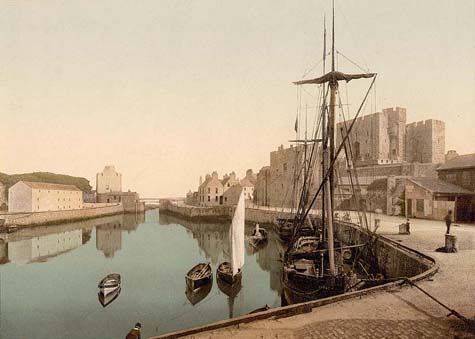 [Image: Castle Rushen, Castletown, Isle of Man, via Old UK Photos].
[Image: Castle Rushen, Castletown, Isle of Man, via Old UK Photos].I was poking around for images this morning and I somehow ended up at a site called Old UK Photos. They collect old, public domain photographs of the UK (rather cheekily including Ireland) – but some of the photos are so extraordinarily beautiful, and so hard to believe that they really are photographs, that I felt like re-posting a few here.
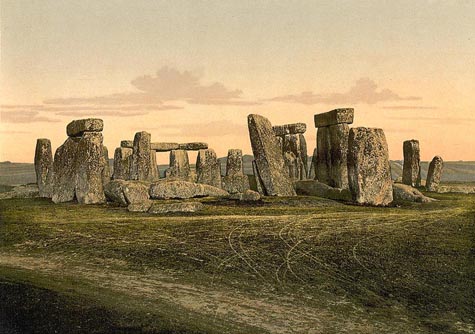 [Image: Wiltshire, Salisbury Plain, Stonehenge, via Old UK Photos].
[Image: Wiltshire, Salisbury Plain, Stonehenge, via Old UK Photos].The fact that I've also been to many of these places adds a weird layer of delayed misrecognition to many of the scenes, as if stumbling upon landscapes from trips I forgot I'd taken (which is almost accurate).
The old pier in Bangor. One of the Peak District caves. Edinburgh castle.
And, of course, Stonehenge, pictured above from those years in which it hadn't yet been fenced off.
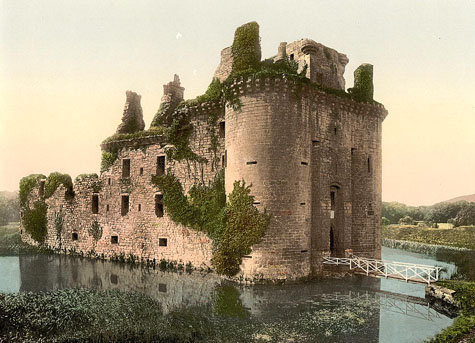

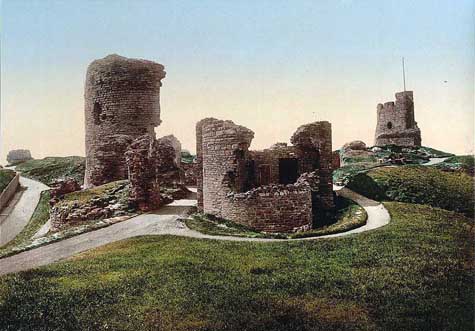
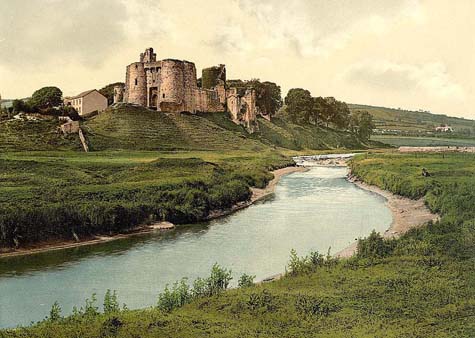
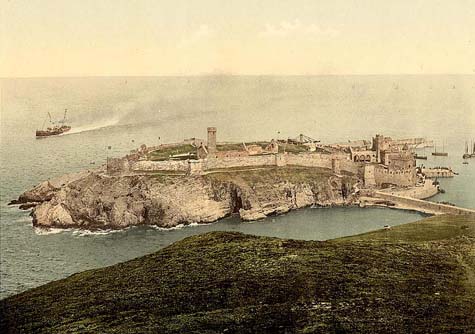
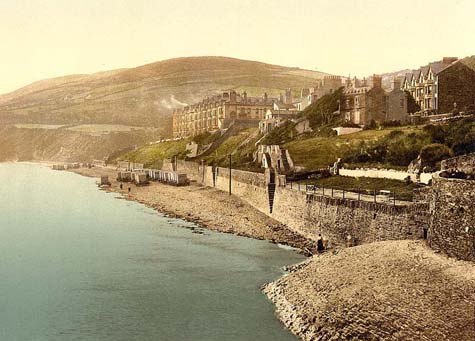 [Image: Caerlaverock Castle, Dumfriesshire; Peel Cathedral, Isle of Man; castle in Aberystwyth, Cardiganshire; castle in Kidwelly, Carmarthenshire; Peel Castle, Isle of Man; and Ballower Mount, Ramsey, Isle of Man; all via Old UK Photos].
[Image: Caerlaverock Castle, Dumfriesshire; Peel Cathedral, Isle of Man; castle in Aberystwyth, Cardiganshire; castle in Kidwelly, Carmarthenshire; Peel Castle, Isle of Man; and Ballower Mount, Ramsey, Isle of Man; all via Old UK Photos].I don't have all that much to say about these, in fact, other than to point out that they seem to instill something between nostalgia (for myself, an Anglo-American) and a wistful need to travel through non-automobile-based landscapes – and perhaps even a somewhat Gothicized sense of fictive possibilities, like something out of BLDGBLOG's recent interview with novelist Patrick McGrath.
That said, then, here are some photos, with crumbling castles on distant hills and even mysterious pieces of old machinery.
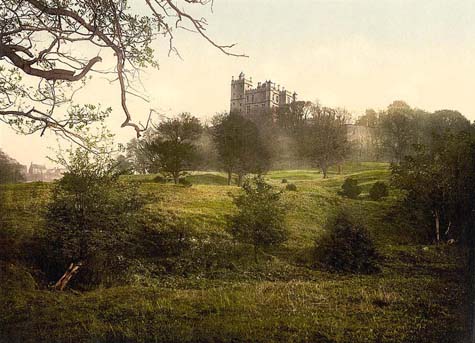

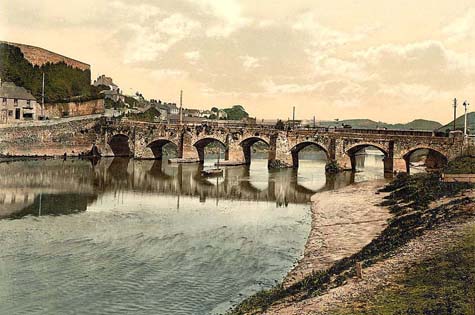
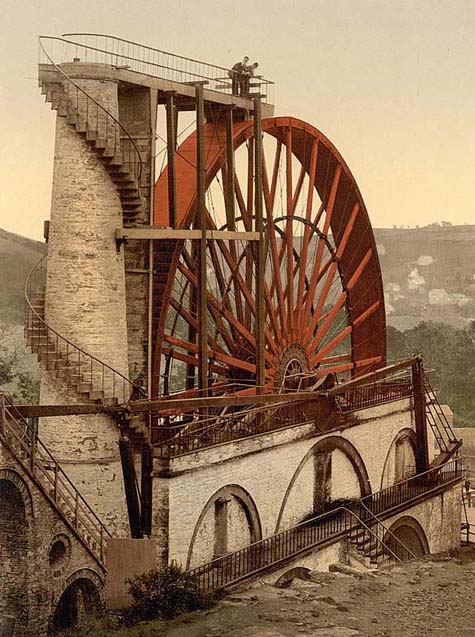
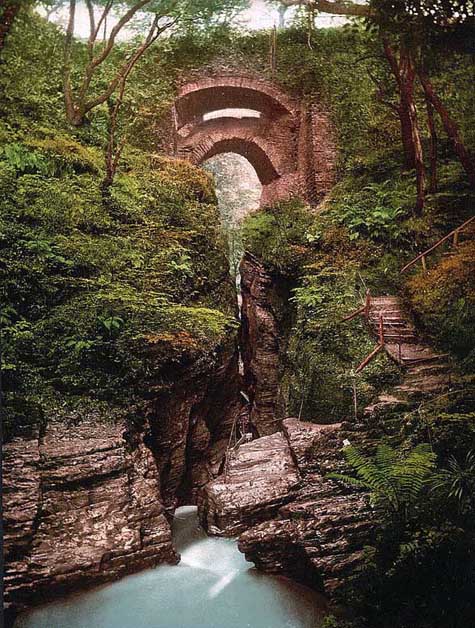


 [Images: Castle at Bolsover, Derbyshire; castle in Kidwelly, Carmarthenshire; bridge in Carmarthen, Carmarthenshire; the Wheel at Laxey, Isle of Man; Devil's Bridge, Aberystwyth; Templand Bridge, Cumnock, Ayrshire; The Blackrock in Cromford, Derbyshire; entrance to a cave outside Castleton, Derbyshire; all via Old UK Photos].
[Images: Castle at Bolsover, Derbyshire; castle in Kidwelly, Carmarthenshire; bridge in Carmarthen, Carmarthenshire; the Wheel at Laxey, Isle of Man; Devil's Bridge, Aberystwyth; Templand Bridge, Cumnock, Ayrshire; The Blackrock in Cromford, Derbyshire; entrance to a cave outside Castleton, Derbyshire; all via Old UK Photos].Some of the coastal photographs – of bays, inlets, coves, rock arches, and cliffs – seem to imply a labyrinthine island geography so complicated and ornate in its expanse, and so remote, that people still must be discovering new places there today... But then, of course, that describes the British Isles. Unless you spend all your time in Leicester Square.
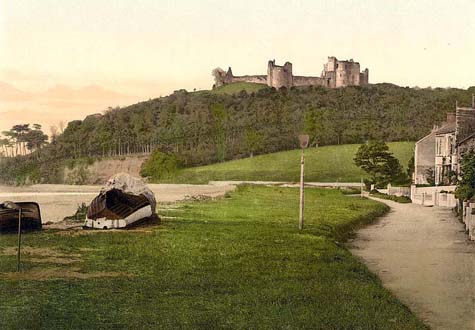
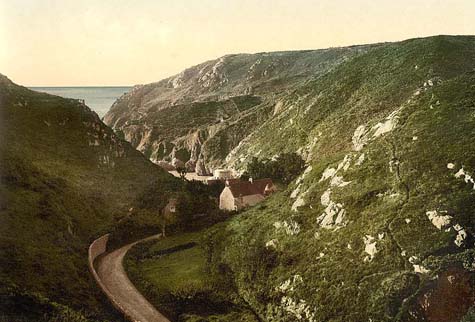
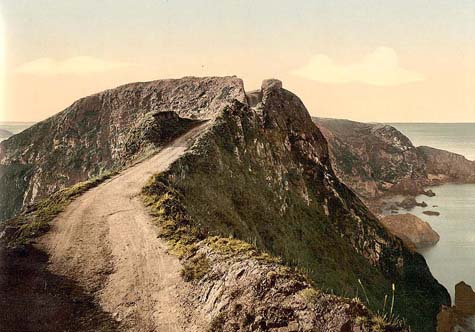
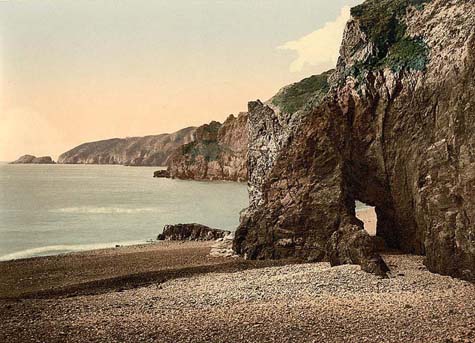
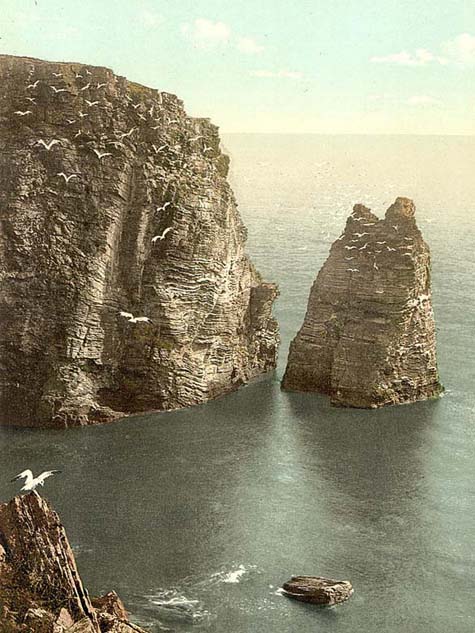
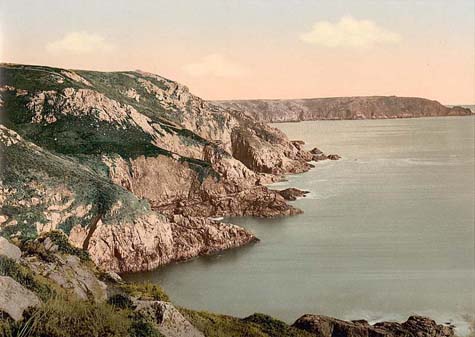

 [Images: Castle in Llanstephan, Carmarthenshire; Petite Bot, Guernsey, Channel Islands; La Coupee, Sark, Channel Islands; Dixcart Bay, Sark; Sugarloaf Rock at Port St. Mary, Isle of Man; the coast at the Gouffre, Petite Bot, and the harbor at La Moye Point (3 images), Guernsey; via Old UK Photos].
[Images: Castle in Llanstephan, Carmarthenshire; Petite Bot, Guernsey, Channel Islands; La Coupee, Sark, Channel Islands; Dixcart Bay, Sark; Sugarloaf Rock at Port St. Mary, Isle of Man; the coast at the Gouffre, Petite Bot, and the harbor at La Moye Point (3 images), Guernsey; via Old UK Photos].Actually, I'm reminded of something I read a few years ago in a book called The Dragon Seekers: How an Extraordinary Circle of Fossilists Discovered the Dinosaurs and Paved the Way for Darwin – which is that a particular stretch of British coastline, near Lyme Regis, is full of fossils.
The book opens with the story of Mary Anning, an amateur "fossilist" – she made an income selling bits of backbones and fragments of mastodons, jigsaw puzzle-like pieces of species that no longer exist – who stumbled upon, if I remember correctly, the body of an ichthyosaur – but only because there had been a landslide. Without that tidally inspired collapse of a nearby cliff, Anning perhaps would never have found her fossil; it would have remained buried in the cliffside for years – decades, centuries – to come.
- Although she had an eye for fossils, she could not find them until they had been exposed by weathering – an achingly slow process. But when wind and rain and frost and sun had done their work, she would find them, peeking through the surface. Others were buried so deeply in the cliffs that it would be aeons before they were ever discovered.
In any case, the bottom two images are from Bangor, Wales, where my brother and I once stayed in a youth hostel and ate soup. We hiked outside of town one afternoon and we looked up at a tree covered in drooping sleeves of loose vegetation, then we fell asleep on a hillside in some farmyard nearby, jumping over a fence and lying down amidst lichen-covered rocks and small bushes.
In fact, I'm a little embarrassed to admit this, but I was reading The Lord of the Rings and so the whole experience was tinged with an air of the mythic.
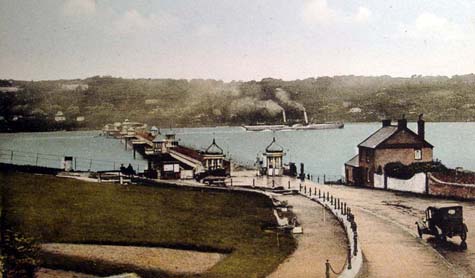
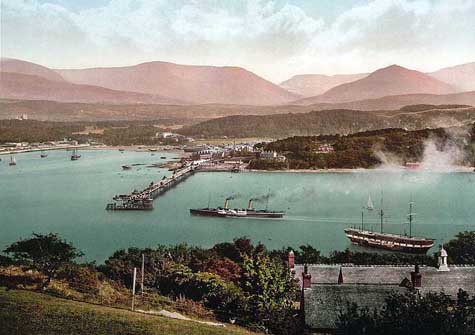 [Images: Garth's Pier in Bangor, Caernarfonshire, and a view of Bangor from Anglesey, via Old UK Photos].
[Images: Garth's Pier in Bangor, Caernarfonshire, and a view of Bangor from Anglesey, via Old UK Photos].Anywho, the old lighthouse at Corbiere, on the Channel Island of Jersey, makes a nice painterly silhouette in this next photo.
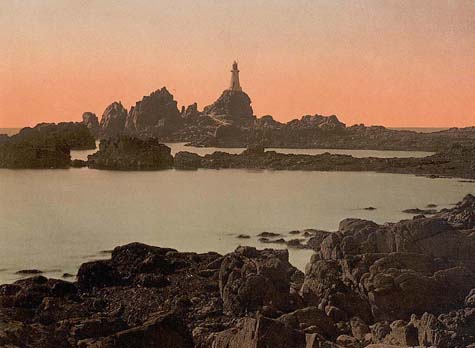 [Image: The lighthouse at Corbiere, Jersey, Channel Islands, via Old UK Photos].
[Image: The lighthouse at Corbiere, Jersey, Channel Islands, via Old UK Photos].And the old paths still whirl and turn through hills, leading somewhere, going everywhere.
 [Image: Moulin Huet, Guernsey, Channel Islands, via Old UK Photos].
[Image: Moulin Huet, Guernsey, Channel Islands, via Old UK Photos]. All of these images, plus a few more, are also saved in a Flickr set I put together this afternoon.
(The title of this post paraphrases a line from William Blake's poem Milton. Meanwhile, it may not be entirely related to the images in this post, but I do recommend giving at least a quick read to BLDGBLOG's interview with Patrick McGrath for some thoughts on the literary impact of these – or similar – landscapes).
Subscribe to:
Posts (Atom)










